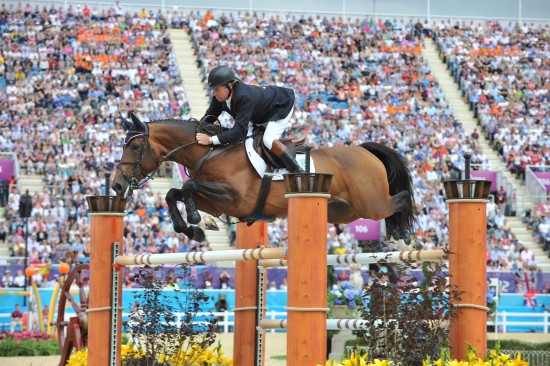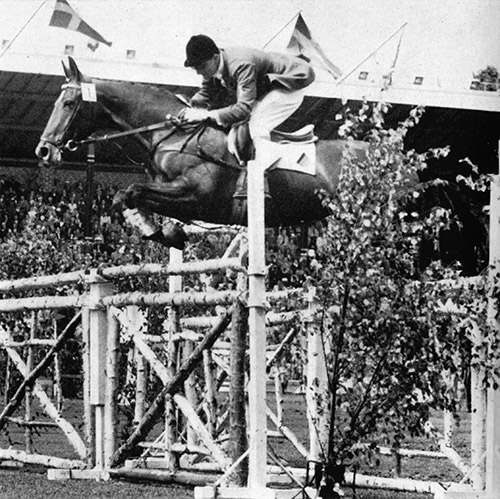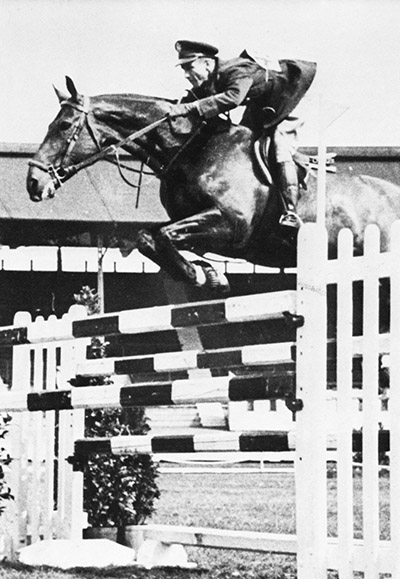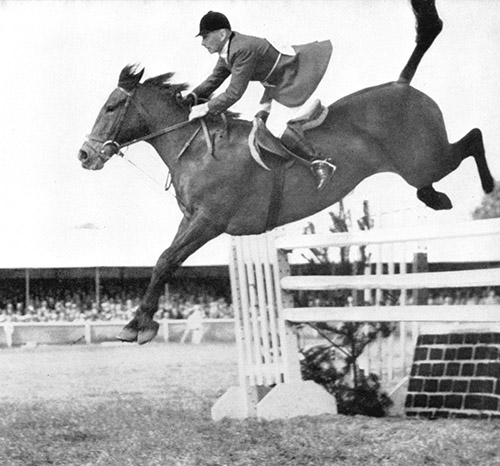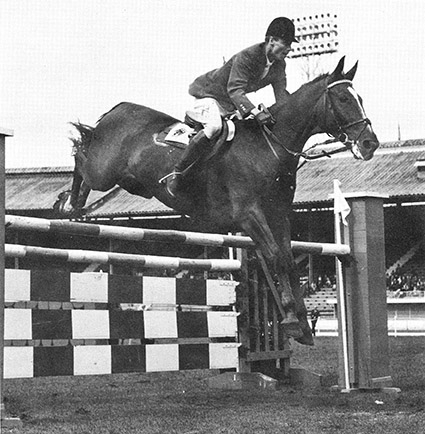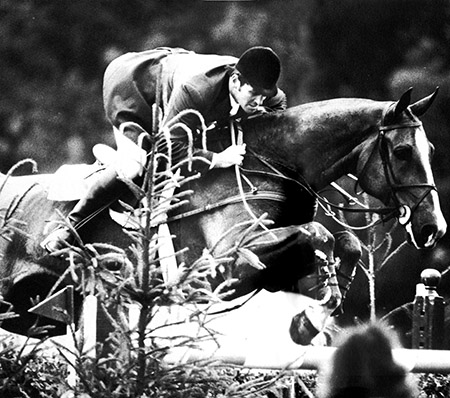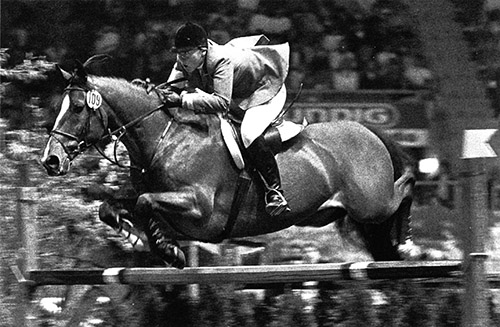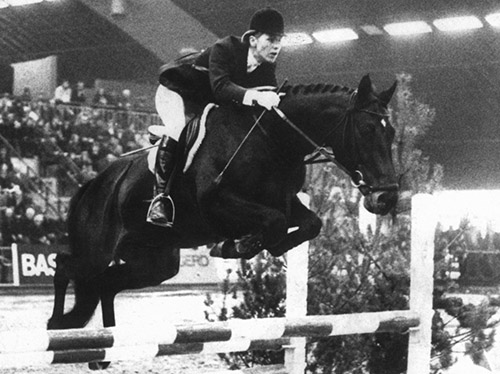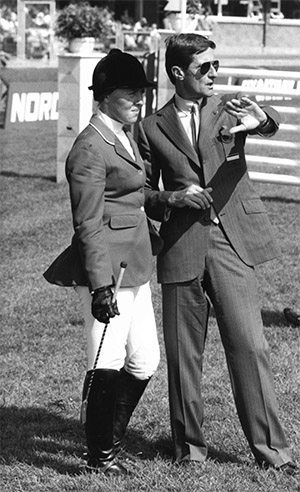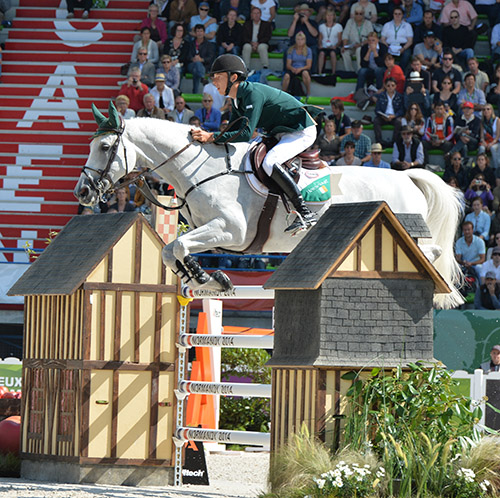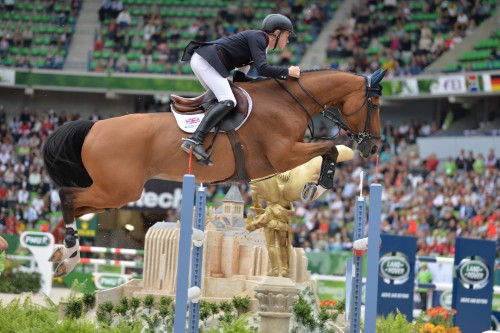Once upon a time, the world of showjumping was a more varied place. Riding styles could vary wildly from Australia’s Kevin Bacon and Britain’s Allan Williams ‘taking a fly’, their heels up round their shoulders at the height of the jump, to the nonchalant grace of the Italians, or the French running wild and free and the perfect stylists who came fresh from the USA.
The horses too were a world of national types – the crossbreds and Irish jumpers favoured by the British and the Italians, the high toned Thoroughbreds of the Americans, and Warmbloods… well Warmbloods were ugly big brutes with jug heads and masses of bone ridden by German gentlemen with well-developed biceps and well-oiled draw reins.
How all that has changed – now it seems all the showjumping world loves the Warmblood, but as we will discover, this has not been an entirely one- way process. The modern Warmblood has evolved and changed in the process of gaining universal acceptance…
And of course, the stereotype falls apart on closer examination. The great Italian teams headed by the d’Inzeos were happy to take their horses where they found them, Ireland, Germany, and even their homeland provided some of the stars, like Merano and Porsillipo. The first great post-War German showjumping star, Halla, started her life as a steeplechaser, and despite her Trotter heritage, looked more Thoroughbred than anything else – and her rider, Hans-Gunter Winkler was a model of elegance and tact.
Halla – German but light and elegant
The British squad training for the 1948 Olympics included Lucky Dip, a Hanoverian captured in a German Veterinary Hospital by the 5th Royal Inniskillings in 1945. Notar, a Hanoverian / East Prussian bred horse who had been a member of the 1939 German Team in Dublin, again ‘liberated’ from a German veterinary facility in Schleswig-Holstein, and Pepper Pot, captured in Austria by the 78th Division. Even Franklin Wing, that stalwart of the early American military teams, rode Totilla – a souvenir brought home from Germany by the US 3rd Army in 1945 – to success in New York in 1947, before the pair won the Grand Prix of Aachen in 1948. And Frank Chapot in one of the early civilian US teams, competed on the German bred ex-Thiedemann horse, Diamant.
‘Liberated’ from Germany for the American team – Totilla
Nonetheless there were plenty of horses on the international scene plucked from unlikely sources. Nelson Pessoa was even riding a Brazilian bred horse. Pessoa was a star on the European circuit in the early 60’s riding his Derby specialist, Gran Geste – by an English Thoroughbred out of a native Crioula mare. Nizefela, the backbone of the post-War British team was by a Shire Stallion, out of an almost Thoroughbred mare. Nizefela pulled a plough in his early days before Wilf White purchased him for £100.
Nizefela – from the plough to the showering…
Similarly, Rusty purchased by the Irish star, Iris Kellet in 1946, had spent the War ploughing the fields six days a week, then hunting on Sunday. In 1948, Rusty beat the world’s best in the international championship in Dublin and in 1949 and 1950 took out the Princess Elizabeth Cup in White City.
Dozent, Ms MacGregor-Morris didn’t like him…
As late as 1966, in her, The World’s Show Jumpers, Pamela MacGregor-Morris could write of Herman Schridde’s Olympic silver medallist, the Hanoverian gelding, Dozent, he ‘is yet another big German horse to have jumped into world class. Yet these horses are by no means everybody’s ideal. They are widely used in Austria, Holland and Switzerland, but a more volatile rider possibly prefers a horse with a temperament more nearly akin to his own. Hannoverians are not popular in France, Italy, Spain, Portugal, Britain or America.’
And even the Germans were changing their style of horse in the early days. In 1965 Hans Günter Winkler was riding Enigk, a Hanoverian, but one with lots of blood, to win the Aachen Grand Prix. Enigk was by the Thoroughbred Endspurt who was bred on both his sire and dam lines to Bay Ronald.
Harvey Smith goes shopping in Germany – Salvador
By 1974, the British rider, Harvey Smith was topping the British money winners for the year (with earnings of £14,000!) on Salvador, a Schockemöhle product.
While Alwin Schockemöhle had caused something of a sensation with his early version of deep, round and low, it was his younger brother, Paul who startled the showjumping world when he appeared on Askan, a grey Hanoverian, who he immediately sold to a rich industrialist for the then record price of £56,000 for Gerd Wiltfang to ride, before the horse was eventually sold to Britain for Harvey Smith. No single individual has done more to transform the breeding and production of showjumping horses than Paul Schockemöhle. It’s a long way from the farmer with his one or two mares to Schockemöhle’s industrial sized breeding factory at Levitz with its annual production of 400 plus foals, and today’s astronomical prices have much to do with Mr Schockemöhle’s flair for horse dealing.
By 1975 in her excellent book, ‘Show Jumping: Officers’ Hobby to International Sport’, Pamela Macgregor-Morris was lamenting how expensive horses had become: “A top horse could have been bought for £5,000 in the immediate post-war years. Now that sum is barely the price of a good novice.”
The first to star in the States – Calypso…
By the 70’s, the Warmbloods were spreading to America in a big way, and one of the very first to capture the American imagination was Melanie Smith’s Dutch bred, Calypso. Melanie and Calypso were second at the 1980 World Cup final, sixth in the 1981 final, and World Cup champions in 1982.
I asked Melanie, who now as Melanie Smith Taylor, is the chef with the US Developing Riders Squad, if she felt personally responsible for the disappearance of those lovely American Thoroughbreds:
“I was one of the first to import horses from Europe, Warmbloods, back in the mid to late 70’s, and that’s what people say – ‘it’s all your fault!’ Certainly it is the way the sport is now. At home if you look at the start lists, you’ll be hard pressed to find even one American Thoroughbred in Grand Prix today.”
Calypso’s sire, Lucky Boy – a Thoroughbred that could jump…
It is a sentiment echoed by Melanie’s long time mentor, and the current chef d’equipe of the US team, George Morris:
“Everything has become universal. Universal riding style, universal training, universal horses, universal courses, it is a very much smaller world, and what has happened to the horse is that what we have is the American Thoroughbred with substance and scope, and the European horse with Thoroughbred refinement – it’s one horse now, and you don’t see the differentiation. Even if you saw a Thoroughbred horse now, it would be a boned horse, or if you see a Holsteiner, it is a blood horse. It is the universal horse but that has happened because the world has shrunk.”
Ironically, George Morris, who loved and still loves the Thoroughbred horse, was instrumental in ‘converting’ the Americans to the Warmblood, when he helped Melanie find those trail-blazing Warmblood jumpers:
Melanie recalls her first exposure to the European horses:
“On my first tour to Europe, George Morris was with me, and we went to La Baule, and to Aachen, and my gosh, they were the biggest shows – I was star struck. I had some lovely owners at the time and George suggested purchasing horses here. I rode exclusively for this one stable and the idea was to bring nice young ones along, and so they decided it would be fun to buy some young ones in Europe and allow me to bring them along. That’s how it happened – we bought Calypso as a four year old,”
Actually on that first encounter, they bought Vivaldi, who was to prove a great speed horse. Melanie’s sponsor, Neil Eustace, in Europe on an antique buying tour, bought Calypso without either the rider or the trainer seeing him! And when he did meet up with the import, George was only mildly impressed:
“When Melanie got him home to Connecticut, I went up to see Calypso, and I liked his bounce. He wasn’t not a big horse, I liked his type, he was a pony type, but a Thoroughbred pony type, and he wasn’t particularly good in front. I was suspicious of him up there, but once Melanie got him to Florida and she entered him in the first preliminary – the class preparatory to open jumpers – he was a winner. He was very very fast, he was very careful, he had sufficient scope, although he was the type, you didn’t know he had Olympic scope, or World Cup scope, until he did it, but he won me very quickly.”
You worked on that front end technique?
“No, no, in my system we don’t work on a horse’s front end. A horse jumps with a style, that will get better, that will get worse, that will maintain, if well ridden, consistently ridden, gymnastic jumping, course jumping, it takes care of itself, or it doesn’t take care of itself. God made that – and this horse being very very intelligent, that style got better. If that horse was a chicken or stupid, that style would have got worse. You can’t fix that. That horse just got better, he was a very smart horse, he was just a winner. He hated to touch fences.”
Calypso was 50% Thoroughbred (actually more than that, since on his dam line we find the Thoroughbred Anblick xx – more Bay Ronald blood), and George likes his Warmbloods to look like Thoroughbreds:
“Even today when I look at horses in Europe, I gravitate intuitively and instinctively towards the Thoroughbred horse, that’s our base, that’s our background, that’s our upbringing – so when they bring out horse after horse after horse, I say ‘that one’ because that’s the blood horse. The big footed, straight pasterned, no wither, clunker, I say ‘ I don’t want to see that one…’”
Melanie also purchased an older horse, the Ibrahim son, Val de le Loire who had already placed second in the Grand Prix of Aachen and Melanie points out that the adjustment of the American style to the imported horses was a two way street:
“When I got Val de le Loire, he was a stopper and I just tried to ride him the way he had always gone. He liked to sort of make a bid at the jump and his rider was a lot stronger than me and could hold him off the jump, but he would just drag me past the distance, and I remember George Morris said to me ‘ you can’t try to adapt to that horse’s style, the horse has to go for you’. At that point we just took a little time off showing and with flatwork and schooling at home, I got him going the way he had to go for me. It took a little time and then he was my horse and he was very successful for me. He was a French horse, they are great horses, but we don’t ride like the Germans and we don’t ride like the French, we have to either find horses that go our way, or make the time to get the horses to adapt to us. We can’t try to ride like the original owners, we have to ride our style and they had to adapt to us. It wasn’t that difficult, really just a mind set but you have to know that it might take a little longer for the horse to go well for you, but it is worth the time because when the chips are down, and you really need to call on them, they have to be your horse, they can’t be someone else’s horse.”
And the new horses opened up new dimensions to showjumping:
“Val de la Loire was just a fabulous jumper, and he was the horse that taught me there was nothing to jumping ditches and banks and waters and liverpools, he never batted an eye. We didn’t have all those natural obstacles in the States and at the time I had a few that wouldn’t jump water and stopped – I’d landed in quite a few ditches and liverpools and water jumps – and it was such fun to have a horse who thought there was nothing to it. Our whole system changed then, we started to have Grand Prix classes, and people started to build water jumps and natural obstacles at their homes, and more shows started to have them.”
Significantly, Melanie’s great star, Calypso, was by the Thoroughbred, Lucky Boy, and perhaps this had a lot to do with the success of the US/Dutch fusion that continues to the modern day with riders like Beezie Madden and Authentic, another ‘Warmblood’ with plenty of blood. Authentic’s dam is ¾ Thoroughbred, indeed her grand-dam is by Lucky Boy…
Melanie prefers the Dutch product:
“The Dutch horse to me is a little bit more of a ladies’ horse – the German horse, a lot of them are more mens’ horses – I’m generalising. You have to find horses that suit you, instead of trying to buy a horse that you think you can change, you try to find one that suits your style, then take whatever time it takes to get to know them and make that adjustment. That’s what I learned – I tried horses and bought horses that suited me more, there was a little less learning curve.”
Meanwhile, that traditional home of the jumping horse, Ireland, was beginning to fall behind when it comes to producing showjumpers, as the farmer / breeders became increasingly out of touch with the demands of the modern sport. Ireland too, was to fall into line, and Irish riders today are more likely to be mounted on a horse from continental Europe than one of their own breeding. Lt Col. Gerry O’Gorman is the head of the Irish Army Equitation School, and he explains the change, thus:
“The original Irish type was the Draught mare crossed with the Thoroughbred, but the old Draught was an athletic, general purpose horse with a super temperament, bone and resilience and courage. They say about the original Irish Draught that it was the work horse on the farm, did the ploughing, went to the creamery every day, hunted on Saturday, and brought the family to Mass on the Sunday.”
“That was the original Draught mare, and that crossed with the Thoroughbred gave the Sporthorse. Then a lot of the Draught mares were exported and the heavier stock were left. Courses were changing, the type of track was changing. The fences weren’t getting any higher but the rideability and the accuracy and the athleticism required became greater and greater. Irish breeders were slow to recognize this and change the model. On today’s courses, the cups are shallow, the poles are light – the older track, the poles were much heavier, the cups were deeper, and you needed a big brave courageous horse and that’s where the courage of the Irish horse came in. Now everything ends up on speed, so the type of animal required has much more ‘blood’, much more athleticism and suppleness, much more rideability, that’s what’s required now, and the breeders have come round slowly to recognizing this, and have brought back some stallions from Europe. But the mare is the most important thing, the mare is 80% – that’s my personal view. It’s not the stallion, if you have the mare then you have 80% of the formula complete if you have the right mare.”
If the breeders were to keep selling to the Irish riders, they had to modify the product?
“Going back twenty years ago, when the Irish showjumping riders realised what was being produced at home wasn’t suiting the track, then they started to look around, and this was tied in with the development of transport and travel, and our riders became exposed to the Warmbloods and they saw what was available in comparison to the very limited market back home.”
As an Executive Member of the newly formed Horse Sport Ireland, Gerry is hopeful of combining the best of the past, with the wave of the future:
“We would like traditionally to support the old Irish breed and we do that whenever possible, but there is a nice mixture. Over the last couple of years, we’ve seen a nice mixture of young stock coming on, a mix of the Irish mares and the Warmbloods, and some of them are turning out to be lovely athletic types with enough blood, enough courage, enough rideability and enough sense to do what is required at the highest level.”
“Horse Sport Ireland, our new foundation, this has created a very business-like professional structure to do with every aspect of the sport horse, including breeding, and not just showjumping but all the disciplines. It’s a new umbrella group under the chairmanship of the ex-Minister for Agriculture, Joe Walsh. That body is making great progress in setting standards in all areas of all disciplines.”
“Irish people are very good stockmen, whether it’s cattle or horses or sheep, they are good farmers and an awful lot of horses are bred as a type of hobby – is it a hobby or is it a business, this is the question I ask a lot of people. Very few are geared towards breeding for performance. We are trying to educate them, we are trying to tell the breeders what type is required because the breeders are not familiar with the international tracks, they are not familiar with the related distances and the technicalities and the athleticism required, so there is an on-going education program through Horse Sport Ireland to the breeders, there is an information gap between the breeder producer and the competitor, and that is the weakness we are trying to bridge.”
The new face of Irish Showjumping – Bertram Allen, and the horse he is starring on, Molly Malone, is straight Dutch, by Kannan (Voltaire / Nimmerdor) out of a Cavalier/Pion mare…
Gerry O’Gorman is aware that there are quite a few who see the introduction of ‘foreign’ blood as polluting the noble and historic Irish breed:
“There are people who think like that, but if you think about it, Vincent O’Brien’s horses won all the Group One classic races at Ascot this week, and that all started when this famous trainer, Vincent O’Brien, started training and he realised what was required, and he set about getting it. He said what does the market demand? What does the competition demand? And he set about getting the best from the States, and England, and he brought them back, and he was criticised for doing that and not supporting the Irish breeders, and look where he is today. In today’s competition world we know the tracks that have to be jumped. Do we have the horses that can do it? How can we get those horses? We have to breed them, so you breed from the model that’s going to do it.”
“You breed for performance – I say to breeders, do an audit on your mares, add up. If you breed the best to the best, you hope for the best, and not all of them will make it to Olympic level, but along the way you’ll have a very nice horse and he’ll do a job at a certain level. But there is not enough concentration given to the business of breeding, of studying the matings and the matching. A lot of it is done for convenience, it’s a hobby thing, and every now and then a fluke comes out…”
“That was the way in the past, and I am happy to say a lot of breeders have recognized what the market needs, what the competition needs and they are beginning to realise that the leisure horse market is well catered for but the high performance animal is scarce on the ground, but we have rounded the corner, and I think that some people are concentrating on the competition horse in a very professional way, and with success, and I am very confident that the graph is on the way up.”
The English have always dabbled with the European horse, but in the last couple of years, the turnaround has been complete, with all the front line British riders mounted on European bred horses. According to Tim Stockdale, it was a natural progression:
“In fairness, it has been an evolution in the sport, with the sport moving on, the type of horse you need has certainly changed. The material at one point was quite natural looking, but then it went to more colours, but still quite big and imposing, and therefore boldness was the key. As the sport evolved, more technical aspects came into the course, and the jumps started to become more delicate and that’s when you need a different horse. As opposed to the stronger, bigger, bolder horse, you need a more agile, more athletic, a more sharp and sensitive type of horse. Because in Germany, Holland, Belgium and France, their horse sport is predominantly showjumping, their breeders concentrate on showjumping horses – whereas in England and Ireland we have a hunting type of mentality. The Europeans were the first to pick up on the different type of horse needed for the evolving showjumping competition, that’s why the Warmbloods are now more specific to dressage and showjumping, and the older fashioned, bolder type of horse that came from England and Ireland, is more and more out of fashion.”
Top placed British rider at the WEG 2014 – Scott Brash and Hello Sanctos – by Quasimodo van de Molendreef out of a Nabab de Rêve mare
Was there much resistance to the European horse in the UK?
“I think there was in the older generation but in fairness, the 70s saw a German horse that was a big powerful brute but not particularly sharp on the old brains… What the European breeders did was bring in the sensitivity via the English Thoroughbred, this is why when you know a little about breeding, you find that the modern sporthorse has a very strong influence via the British Thoroughbred. We had that, and we exported it and allowed them to use it in their breeding program.”
Did the British riders have to adopt different riding and training strategies?
“I think as the sport has evolved, it has become a lot more technical. It’s not a question now of being brave and riding down. If you look at the style of the older generation, and the style of the newer generation, there is a huge change. The need to have your horse between your hand and leg, having your horse much more supple and balanced, and very much more responsive, means you have to be better at the dressage and the technicality of being able to ride on the flat – which was maybe not the case a few years ago.”
It’s a trend that gets stronger and stronger. Australian showjumpers who traditionally relished their $500 racetrack rejects who went on to be international jumpers (yes, about 0.001% of them) are now all riding Warmblood bred showjumping horses at Hong Kong and even the French, for so long the most chauvinistic of horse breeding nations, are more and more likely to be found sitting on a horse with German, or Dutch, or Belgian blood – whether imported, or as is increasingly the case, bred in France. And while we may miss the idiosyncrasies, the little quirks of national character and style in the competition ring, it’s never going to return. The universal jumping horse is a reality.
Perhaps the major factor has been the change of courses. Leopoldo Palacios (who spends 46 weekends a year building showjumping tracks all around the world) points out: “Years ago, riders used only Thoroughbreds and the Thoroughbreds, I believe, are wonderful horses – however in the sport today, the courses are made for Warmbloods. The difference is if you look at the old courses they have 700 metres, 14 fences, now it is 480 metres and 14 fences. For the Thoroughbred, it is difficult jumping the fences so near one to the other. The mind of the Thoroughbred is more hot.”

